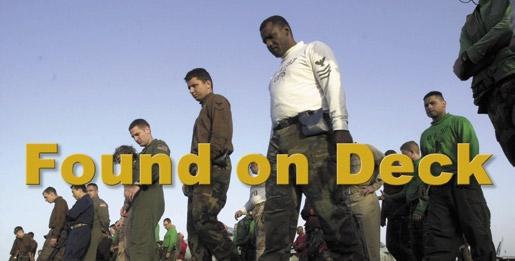
4 minute read
An Encounter With Afghan Concrete
By AE2(AW) Evan Hodges, VAQ-134
As with most stories in Mech, the day started off just like any other, but it didn’t end that way.
Advertisement
First, I’d like to talk about the things that I do remember. I recall being at work early in the day and performing standard maintenance on one of our Navy EA-6B Prowlers at Bagram Air Base, Afghanistan. Even though we are forward deployed, our maintenance practices are exactly the same as back home.* First and foremost, we always wear our personal protective gear (PPE)—and doing so on this day may have saved my life.
We have to get the rest of my story from my shipmates, who later told me and our flight surgeon what had happened.
According to one of our line division personnel, I was troubleshooting an electrical discrepancy while sitting in the pilot’s seat of Garuda 542. When I stepped out of the cockpit, I placed one foot on the external boarding platform, and then the other. Apparently I felt confident enough in my footing that I released my grip on the aircraft canopy—definitely a mistake.
Even though we don’t see much rain or freezing temperatures in Afghanistan, there was enough moisture on the boarding platform for it to be slick.
As I let go of the aircraft, both of my feet slipped out from under me, and I literally was launched into the air horizontally. I fell eight feet, measured from the top of the platform to the concrete below.
You’ve heard it in Mech before, but it’s worth repeating: Wearing a cranial probably saved my life. My head and back hit the ground, bounced up and hit again. I

reportedly was unconscious for around 30 seconds. The first person to reach me said I was twitching and unresponsive. I was able to talk when I finally came to, but I couldn’t move and had no feeling in my limbs. One of the aircrew who was getting ready to fly ran up and asked me my name and if I knew where I was. I guess I had the presence of mind by this point to tell him, “I’m in Bagram; I fell on my butt, and I want to get up!” The emergency crew arrived in less than three minutes, and I was transported to the base hospital for X-rays and a CAT scan. After several hours of observation, I was released and diagnosed with only a mild concussion. This is where my part of the story can resume because the missing seven hours ended with standing in front of my B-hut, wondering how I’d gotten there. I’m told that after a head injury like mine, a person often will experience short-term memory loss for several hours. That’s exactly what happened to me. I wish I could go into detail about the fall, but I honestly have no recollection of it.
Fortunately, I recovered quickly. Always be aware of your surroundings. I’ll always make sure I have four body points of contact before letting go. As for my PPE, it goes without saying that I’ll always wear it. *All deployed squadrons should operate in this manner. —Ed.

By AS2 Thomas Bach, USS Kearsarge (LHD-3)
It was a beautiful morning off the coast of North Carolina as word was passed from the 1MC, “All hands are cordially invited to the flight deck for a FOD walkdown.” Personnel were coming from all directions.
We all lined up and commenced the FOD walkdown. As the group approached the aft end of the island structure, ball bearings were found between the island and the A/S32A-36A amphibious assault crash crane, “Tilley.” Post-walkdown analysis of the FOD recovered led to immediate tasking to identify the source of the ball bearings.
A close inspection of the crash crane by numerous support-equipment technicians revealed the source of the FOD. The doors on the engine-hood assembly of the crash crane use ball bearings to assist in opening and closing. The doors had been removed, and eight ball bearings were missing.
Further investigation produced an additional five bearings that were out of the track, as well. The door-slide track was damaged and would not hold the bearings in place. Review of current Periodic Maintenance Instructions did not reveal any requirement to open, close, lubricate or inspect the chassis doors. A recommendation was submitted to the CFA to add an MRC to include these steps at a specified interval.
This incident paints a clear picture of how important the PMS program is and how it relates to the FOD program. Foreign object debris can come from many places, including our support equipment.
AS2 Bach works in AIMD.










